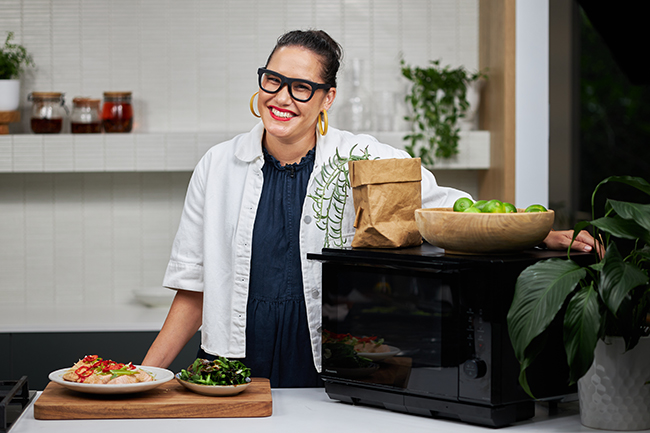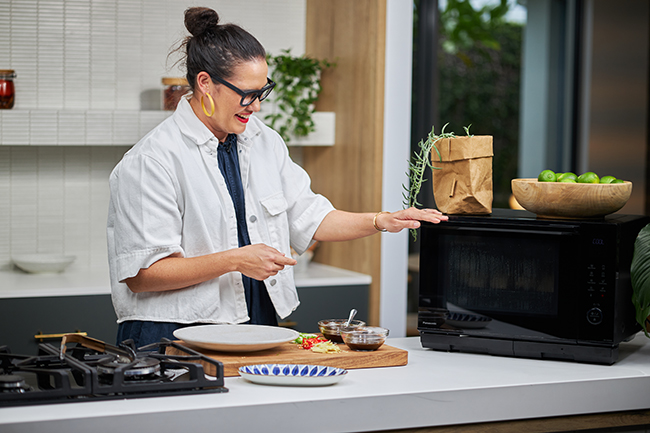Featuring air fry style cooking for crispy, delicious results
Panasonic has launched its latest Combination Steam Microwave Oven, allowing everyone from the busy family, the food prepper and the creative cook to easily enjoy tasty meals and preserve healthy nutrients.
The NN-DS59N Microwave features four different cooking methods – steam, oven (top-bottom heater), grill and microwave power. This puts an amazing variety of recipes at your disposal, from steamed fish and vegetables to spicy, crispy chicken wings or even chocolate cake.
Much loved Australian cook and Panasonic partner Marion Grasby put the new Microwave to the test and said:
“I’ve been a proud Panasonic partner for some time now and I’m always super impressed by the amount of tech they put into their appliances. This new NN-DS59N Microwave is no exception. I especially love the healthy grill function. It’s awesome to be able to make air-fryer style food on a flat tray (as opposed to a cramped air fryer basket) – I even made some epic air-fryer style wings!”

Level up your kitchen repertoire
Steam Cooking
Steaming preserves nutrients and maximises taste for an overall healthy and delicious experience, especially when cooking fish and vegetables. Thanks to the integrated 600ml water tank and boiler, the NN-DS59N delivers a powerful 1100 watts of steam. The steam completely fills the oven, so you can quickly cook an entire meal such as fish and vegetables in just 15 minutes. The steam function can be combined with the oven (top-bottom heat) and grill functions for impressive cooking flexibility. This is perfect for recipes like gyozas which can be steamed on top and grilled on the bottom.
Air Fry Style Cooking
Air fry style cooking achieves healthier low-fat cooking and crispy results on all sides, from mouthwatering lamb skewers to potato gems and crunchy vegetables. Panasonic’s unique grill tray is designed so that fat released when cooking runs down the grooves, removing oil so that food is juicy on the inside and crunchy on the outside. During cooking, microwave power heats up the bottom of the Grill Tray, while the grill function works from the top.
Automatic Functions for Perfect Results
Cook using two or more heat sources at the same time for tasty meals that are ready faster. With the choice of up to six Combination Cooking programs, you have the right cooking method for the best results at the touch of a button. Other capabilities that make preparing meals a breeze and guarantee great results every time include:
- The Genius Sensor, an Auto Reheat function which measures the moisture in food and adjusts cooking times to achieve the best results
- 28 Auto Programs to cook everything from baked bread to steamed rice
- Inverter Technology to cook meals up to 40 per cent faster

Easy Cleaning
Cooking is more enjoyable when clean-up is easy. The flat grill heater and flat stainless-steel interior are simple to wipe down and four automatic cleaning programs – such as Cavity Cleaning which uses hot steam – keep your Microwave spick and span without the fuss. The compact design includes a cavity with a large 27 litres of space, giving you the flexibility to use a range of cookware. Plus, no turntable means fewer components to wash, also saving water, and the Grill Tray is dishwasher-safe.
Stylish and Durable
The microwave has a sleek, compact design to suit a range of kitchens. The frameless downward-opening glass door, the easy-to-see touchscreen control panel and the LCD display with white lettering are all ergonomic and stylish. The NN-DS59N undergoes rigorous factory testing to ensure lasting reliability. Dedicated Panasonic robots press the buttons more than 60,000 times and open the door 150,000 times – movements that would normally be made over the course of 15 years.
Pricing and Availability
Panasonic’s NN-DS59N is available now from leading consumer electronics retailers, priced at $919 RRP.
To enjoy Convection Microwave recipes, tips and more on the Panasonic Home Appliance range, visit @panasonickitchen_au. For further product information, please visit www.panasonic.com.au or call 132 600.

